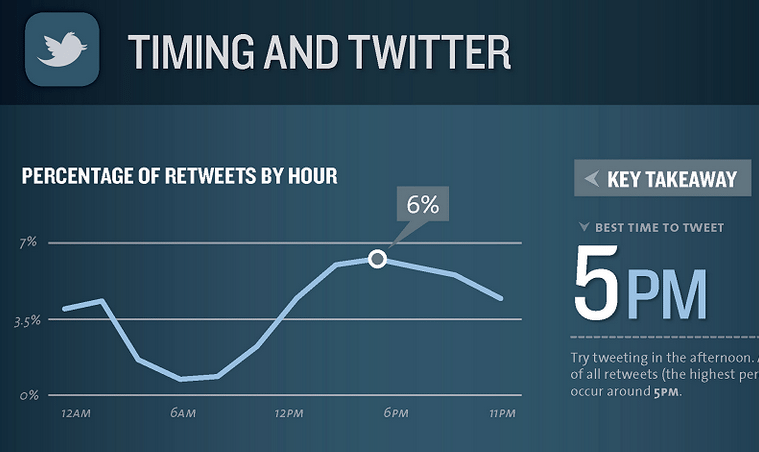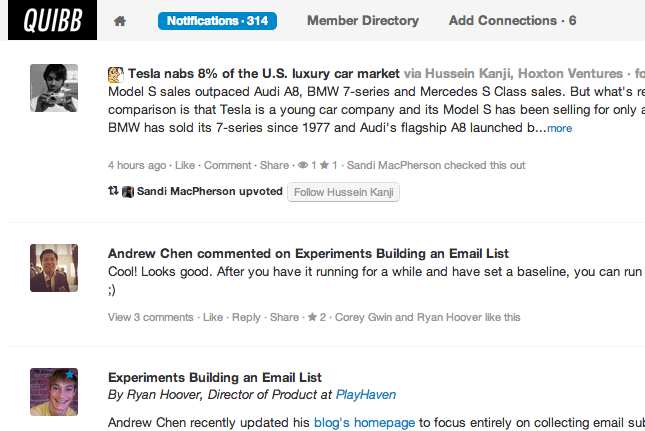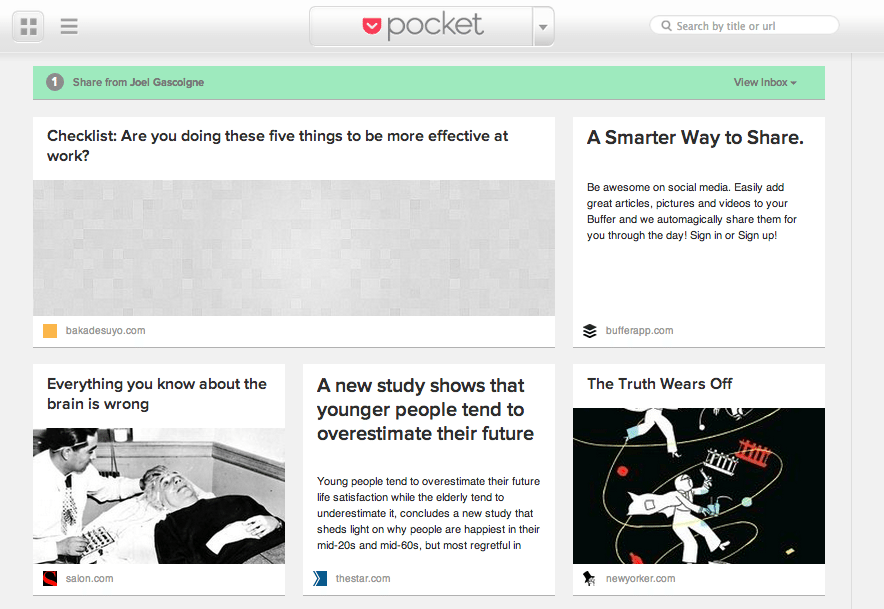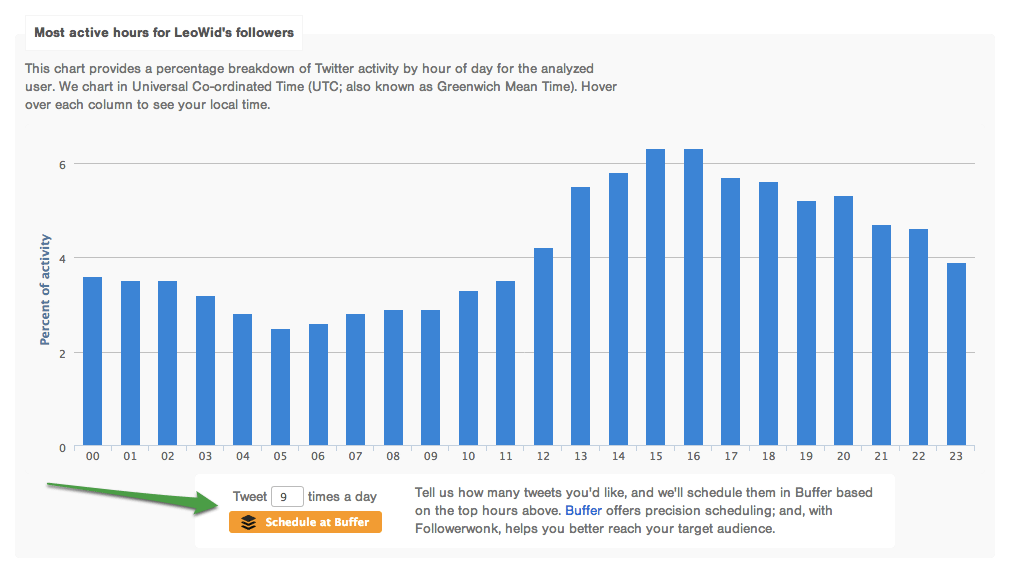The Complete Guide for Finding and Sharing Better Content on Social Media
Our biggest aim at Buffer is to help you share content on social media in better ways. I wanted to look at ways we can help you with this entire process, from finding the content to sharing it, to analyzing your social media posts. So I’ve uncovered some cool ways to do these things that you might not already know.
Why find and share great content?
Maybe you’re wondering why we focus so much on discovering and sharing awesome content here at Buffer. There are a few reasons that apply to pretty much anyone who shares great content with their followers:
1. Sharing content triggers faster growth of your social media communities.
If you’re trying to increase the growth of your communities, sharing awesome content is a good way to give them a reason to follow you or visit your page regularly. It also gives your current community members more reason to share what you’re doing with their friends, which increases your reach.In one of our previous posts, we found that the optimal number of tweets to engage your followers is 1-4 per hour, and for Facebook it’s no more than 1 per day. Using Buffer to space out your tweets and share content regularly can help you fill this quota, particularly for Twitter.

In this video from Moz CEO Rand Fishkin, he explains how creating content that answers common questions you see time and time again in your community can help you to gain more followers and build a stronger community.
2. Sharing content helps to build your authority.
As you share more useful, interesting content, your authority within your niche or industry begins to build. Eventually, you will become known as a knowledge resource for your followers if you regularly post great content.
Our CEO Joel shared more thoughts on why sharing content is a good idea in this post, including being in touch with more people and starting (and learning from) interesting conversations around the content you share.
3. Sharing content helps you to engage with thought leaders
Rand’s video also explains some great tactics to build links to your site using Twitter. One of the strategies he talks about is sharing suggestions with thought leaders who have created content in your industry. For instance, if you see a great piece of content that’s missing something you’ve written about before or a product you sell, you can use Twitter to suggest it to the thought leader who created that content. This is a great way to build up relationships with leaders in your industry.
How to find great content
If you’re looking for great content to share, there are lots of places to look. These are some of my favorite suggestions for ways to discover great content you might not know about already.
Little-know content treasure chests:
- Quibb This is a content-sharing network based around “what you’re reading for work.” It’s a members-only site where you can connect to other professionals to share and have conversations about great content:

- The Feature This nifty site was originally started by Instapaper creator, Marco Arment, and titled Give Me Something to Read. Now you can find The Feature inside Instapaper or Flipboard as well as on its own site. It’s a curated collection of awesome content based on what articles people are reading in Instapaper. I never fail to find something great to read when I look here:

- Inbound: Another incredible resource, especially for marketing, SEO and social media content is Inbound. It’s a new, Reddit/HackerNews like community build by Rand Fishkin and Dharmesh Shah to help you get the latest insights about all things Marketing. The community that naturally formed there is incredibly helpful, uplifting and supportive. Whenever I head on over there, the quality of the content is always extremely high and well filtered:

- These particular subreddits: There are so many subreddits that it can be hard to work out which ones are most useful for discovering great content. If there’s a specific one (or several) for your industry, that’s probably a good place to start. Two more general subreddits that I really like are TrueReddit and FoodForThought. Both of these are full of interesting, thought-provoking articles worth reading.
Discovery engines
- Prismatic: The Prismatic site and iPhone app both aim to learn about your interests and help you uncover interesting content that you might ordinarily miss. Both versions let you dismiss content that’s irrelevant so the site can learn more about your tastes. Update: As of December 20, 2015, Prismatic has shuttered its consumer-facing app.
- Quora: While it’s technically a Q&A site, Quora answers contain lots of interesting links to studies, articles, blog posts and other content. I’ve found this is a great place to check in on every morning to uncover interesting things to read and share.
- Flipboard: Flipboard’s iOS and Android apps let you create, share and view curated ‘magazines’ of content. You can also follow authors and particular blogs or websites within Flipboard to keep up with relevant content.
- StumbleUpon: When you’re in the mood for something new and don’t know where to look, StumbleUpon is your friend. By choosing topics that interest you when you sign up, you’ll be able to browse suggested content that fits into those topics, vote it up or down and share it with your community.
- Zite: Zite works a bit like a cross between StumbleUpon and Flipboard. It’s a mobile app that lets you follow topics like StumbleUpon does, but presents them in more of a Flipboard style. As you browse content inside Zite, you can vote it up or down to help Zite learn what you like and show you more relevant content in the future. Update: As of December 07, 2015, Zite has also closed its doors.
RSS and Twitter
Joel’s post also mentions a couple of great suggestions for using RSS and Twitter to find great content. Joel found that his problem with RSS was subscribing to too many feeds—something I’ve definitely found to be an issue before, as well. Cutting back on the feeds he subscribes to made Joel’s RSS reader more useful when he was looking for great content to read and share.
On Twitter, Joel suggests creating Twitter lists of selected users, which has a similar effect to cutting down your RSS subscriptions:
It wasn’t long before I’d followed more than a few hundred people on Twitter and it became a bad idea to try and read every Tweet. These days, that’s simply impossible. I think this is actually great – I much prefer a stream from a large variety of people which I can dip in and out of, than limiting my stream to a tiny few people and trying to read anything.
However, lists are the magic balancing these two ideas for me. There’s just one key list I use right now, which I can always glance through
Read later apps
So many of us are used to constantly coming across interesting content during the day that we want to read, but not having the time to stop and read it right then. Or, stopping to read it and interrupting our workflow. Read later apps help us with this problem by tucking away the content we discover throughout the day for a more convenient reading time later.
Most of these apps also come with some form of discovery features built-in as well, so you can see what other readers are enjoying or sharing within the app.
- Instapaper Available on almost any device, Instapaper’s goal is very simple: it strips away every on the page you’re viewing except the text. If you’re a fan of reading long-form articles, this is a great app to use.
- Readability This app has a very similar goal to Instapaper, with a really reliable process of stripping away everything around the text and making your content easier to read.
- Pocket One of our favorites at Buffer is Pocket, which has some of the best sharing features of any read-later apps. With pocket, you can save a link from a tweet to read later, and then if you enjoy the content, you can rewteet that original tweet from right inside the article view in Pocket!

- Pinboard Pinboard’s integration with other sites is fairly broad, making it really useful if you like to automate the process of pulling links in to read later and sharing your favorites after you’ve read them. It’s actually a bookmarking service, but it also offer a read-later option.
How to share your content
Sharing content can be as easy as tapping a button, but the more we learn about social media and what people respond to, the better we can make our sharing processes.
Choose the right time
Finding the right time to post your updates can be tricky, but luckily there are some great tools out there to help us with it. One that’s really useful it Followerwonk, which helps you to work out the best time to tweet based on when your followers are around and likely to respond to your content. With Followerwonk’s integration with Buffer, you can import that suggested schedule into Buffer with one click!

For more general rules, our recent post of surprising Facebook stats suggested that Thursdays and Fridays are the best days to post on Facebook, with an 18% rise in engagement on those days. Sharing photos on Facebook is known to improve engagement by 39% as well, as compared to normal text-based updates.

Did you know you can use Buffer to share image posts to Facebook? It’s one of the many little-known tricks of Buffer. If you have the browser extension, you can simply right-click on an image and choose to share it as a photo post.

Connect Buffer to tons of apps for better content sharing
There are lots of other easy ways to share with Buffer. With our new custom scheduling feature, you can even schedule your updates for a particular date and time, if you’d rather not add them to your buffer. With the browser extension installed, you can share any web page you come across just by right-clicking or clicking on the Buffer button in your browser. Of course you can also add updates to your buffer account with our mobile apps, both of which now include custom scheduling.
Probably my favorite thing about using Buffer is how it’s integrated into so many other apps. This makes sharing even easier, since you can do it from within whatever app you discovered or read the content in to begin with. RSS readers like Feedly:

It also works from Reeder for iPhone and Mr. Reader for iPad all include Buffer sharing options. Read later apps like Pocket and Instapaper have Buffer sharing, and so do Echofon and Twitter.com, so you can even buffer retweets!
You can see all of the integrated apps here.
Linking your apps together through IFTTT
If your favorite app isn’t integrated with Buffer yet, you can definitely get around this (and even if it is, sometimes linking your apps together can save you time anyway).
IFTTT is an awesome tool that lets you link lots of apps together in different ways, making your content workflow much more simple and fast.
Using an IFTTT recipe lets you hook up a whole bunch of services like Twitter, email, Facebook, Dropbox, Pocket, Instapaper and more, as well as Buffer. You can send links to your read later list, save them as bookmarks and easily add to your buffer just by adding a tag. For instance, anytime I save a link to Pinboard with the tag ‘buffer,’ IFTTT adds it to my Buffer account.
You can browse IFTTT’s Buffer recipes list or create your own.
How to analyze your posts
Once you’ve got the discovery and sharing of content working fine, you’ll want to know how well your posts are being received so can optimize them for your audience. Here are some of the ways we’ve found to work best.
Track clicks, retweets and favorites
One thing that we’ve found most valuable when sharing content is to keep close track of your analytics. In our case (duh!), we use Buffer to see detailed analytics on each of your posts, including how many people commented, liked, retweeted or replied to your posts. You can also see how many people saved a tweet as a favorite or clicked through to a link you posted.

Click-throughs are important for testing the way you phrase your post headlines, the timing of your posts and how interesting the content is. Comments, replies and retweets are really useful for seeing how engaged your audience is around particular content or general topics.
A/B Test different headlines
Something we do with almost every post we share from the Buffer blog especially, is to test several different headlines to see what works best. Sharing the same post within a couple of hours using multiple headlines can help us work out which one matches the content and makes it seem the most interesting.
Here’s how we found this process to work best:
For Twitter, we’ve experimented with A/B testing the right headline. A/B testing on social is arguably very hard. Yet we’ve found it’s possible to still get reliable data that way. Here is how we approached this:
1.) Find 2 headlines for an article that you think will perform well.
2.) Tweet both of these headlines at roughly the same time, at least 1 hour apart. Here I’ve found that doing the 2 Tweets both in the AM or both in the PM works best – 9am is much more similar to 10am, then say 12pm is to 1pm. So going with clear “morning” or “afternoon” times is crucial.
3.) Compare the data for which headline to settle on.
So those are our best secrets for finding, sharing and analyzing content on social media. You can also read more about using Buffer to share on social media here, or what the best time for posting is, here.
You can read more about this process in this post: A scientific guide to writing great headlines on Twitter, Facebook and your Blog
If you’re after some more tips to share great content on social media, you might like one of these previous posts: 3 Awesome new ways to share all day long with a full Buffer, How to find and share the most popular links for the topics you are interested in. And of course, we’d love to hear about what works for you—how do you find awesome content to share with your community?
Try Buffer for free
180,000+ creators, small businesses, and marketers use Buffer to grow their audiences every month.
Related Articles
Here are the top 12 courses to improve your social media marketing skills.

A step-by-step guide to scheduling your posts to Bluesky, cross-posting to other platforms like X or Mastodon, and even creating threads.

In this article, I’ll share why you must tailor your social content to each network and give actionable advice for each platform.